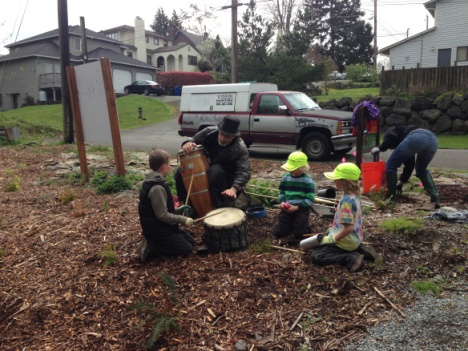This morning’s post in the series Creating Sacred Space comes from Mary De Jong. Mary leads personal discernment pilgrimages/retreats to Iona, Scotland and locally in the Great Pacific Northwest. She is also, slowly, pursuing graduate studies with a focus in ecotheology. She is a Green Seattle Partnership Forest Steward, and is co-founder and co-chair of Friends of Cheasty Greenspace at Mt. View. She lives in the Columbia City neighborhood of Seattle, WA (USA) with her husband and three children. It sacred space than what I talked about was first published on Waymakers the blog.

Ed beats out the rhythm
The detective called inquiring after whether or not we had found “anything” in the woods since the fatal shooting that occurred near Cheasty Greenspace/Mt.View on February 4, 2013. While we have certainly unearthed some curious, and somewhat disturbing, artifacts during our forest restoration work parties (lined up pairs of shoes next to an axe, dismembered dolls, rosaries, and large singular bones to name a few), no, we had not found the weapon involved in this fatal incident. He went on to inform us that a team of officers with metal detectors and a K-9 unit would be canvassing the area the following day. Mind you, just a few months ago, there was the horrendous reality check that came along with 40 search and rescue volunteers and cadaver K-9 units looking for the remainsof a young women in Cheasty/North, so I was already edgy about the resurfacing street-cred of our Rainier Valley forest. However, I don’t think I was prepared for the potential emotional unraveling the impact of this dynamic in our beloved forest would have on me.
You see, we have been faithfully involved in the reclamation and restoration of this urban forest for the past six years. We have hosted over 80 community work parties dedicated to the vision of reimagining this landscape as a safe and welcoming resource for our neighborhood. We have written for, and received, grants that have funded our hope to build trails within this 10 acre woods that would connect neighbors, encourage walking to public transit, and provide local access to nature. And the beauty that has resulted from this grand grassroots effort is as real and glorious as the noon-day sun!
What used to be a landscape filled with invasive plants, such as English ivy and Himalayan Blackberry, and illicit behaviors, such as prostitution rings and illegal drug trades, has been replaced with the balance that true restoration brings. Our native Northwest understory is thriving due to the absence of ivy. Children now play in the forest, and their laughter mixes with the chatter of songbirds and the cries of our resident Red Tail Hawks. The trails are a resource to neighboring youth organizations who now can bring their students into their own backyards to study, learn and just be in nature. Our neighbors, who have worked literally shoulder to shoulder for years to see the effects of this hope-filled vision, have become a networked community of friends and families. These woods have become apart of the vibrant, social fabric of our neighborhood.
And so my heart was heavy when I saw dozens of marked and unmarked police vehicles lined up against our trees. My spirit sunk when I witnessed uniformed men, shoulder to shoulder, working their way through freshly budded Indian Plum, Trillium and Sword Fern. Their presence conjured up the spirit of negativity that brooded over this place for so many years, the very spirit that we have worked so hard to drive away from this place. I felt my repose unravel and give way to the erosive work of despair and hopelessness. ”You can never change these woods,” the line-up of police cars seemed to sneer. “These woods will always be the cover for dark deeds! No vision for hope and help can changethat!”
I awoke the next day to clouds over my head and heart, hardly able to utter a morning prayer, but with the imperative to get out of bed and prepare for our monthly work party we host. Begrudgingly, I set out shovels, buckets and First Aid kit. Grumbling, I laid out our registration table materials and sign up sheets. Demoralized, I wondered if this slow and steady, long term effort to affect change in our little corner of the world was even worth it anymore. Yup. My little pet dark cloud was beginning to rain on me.
However, contrary to Saturday’s Seattle forecast (and my attitude), sun began to beam on South East Seattle and neighbors began to convene at our home to gather up tools and gloves, and log their dedicated time towards making a tangible difference. And then Ed approached, scuffed toe-shoes ambling down our sidewalk, threadbare coated-arms raised in greeting and dusty top hat ready to blow away with the wind. I presumed he was on his way past our home to visit one of our neighbors, who are involved in some unsavory practices…but he stopped. Right in front of me. And smiled. Turns out, he was here for our work party, but his car ran out of gas and stalled in the middle of the street, just up from our main trail head into the woods. Can I help, he asked? My heart softened towards Ed; of course, I can help, but give me a minute to kickstart the volunteers and get the work party going.
Lesson #1: It always amazes me what kind of help shows up in a minute. The momentary pause before immediately responding to a need that you know you can meet is almost an invitation to allow those around you to participate in an assistance that is easy to presume only you can do. All that to say, when I was able to finally direct my attention back towards Ed, Neighbor Mike had already fixed him up with a five-gallon gas container and a Seattle Parks worker was ready in the wings to tow his truck to safety. I felt a sun beam penetrate my hopeless haze. This community that has been created through a hope for the common good, without question, took care of a stranger in our midst. My heart tried to soar with the pride for my ‘hood, but quite honestly, I figured I would never see Ed again and that sense of being “had” was enough to tether my fragile mood.

I followed the last volunteers up into the woods and was mentally making a game plan for the variety of ferns we would be planting (grown by spores from a forest friend), and how we would disperse the five cubic yards of mulch, when I was called out of my reverie by the beating of a drum. The repeated rhythm was coming from the trail head where we would be working for the bulk of our work party. I crested the trail into view of the forest’s entrance and there was Ed, top hat and all, sitting on a stone, surrounded by a medley of musical instruments and a growing number of children. Ed smiled at me and proceeded to play music for the duration of our work party. Trombones, clarinets, bongos, tamborines, all were enlisted to lift the spirits of the volunteers and provide a special joy for the children. Oh, forgot to mention the unique detail that we were the host-site for a local preschool co-op parent group who wanted to participate in a local Earth Month volunteer opportunity. We had dozens of preschoolers running around the woods on Saturday. And it would be important to note, too, that the sun shone during our entire work party. Sunshine. Children. Music. Ed. My heart was unfettered and finally flew.
Now, some who knew of these back to back unique and unplanned occurrences probably could just attribute it to the Wheel of Fortune, for that would explain such a social spectrum in Cheasty Greenspace. However, I’m one who is always interested in the quiet cadences of God and what one would call a coincidence, I’m eager to see thesynchronicity. Essentially, this means that when you really need something, and often when you really want something, it is there. Furthermore, the ancient practice of pilgrimage maintains that help, and the divine answer, are most often found in the company of a stranger. Pilgrimage is this radical practice that turns upside down the ways of the world; in each other and in the strays and strangers en route, pilgrims meet-not the paupers-but the princes. In the gestures and greetings in gravely roadside places, prayers are answered, and what you are in need of is given. In this nontraditional way of journey-living, the road taken to a better place is one where divisions are bridged: race, status, and gender are irrelevant. I would further go on to say that this mode of being also exists in Nature. For in the woods, all are recipients of the goodness and grace inherent in nature. All are apart of the greater community of things. And to a degree, all become Kings.

Lesson #2: Rough, worn edges and the grime of a harder-than-mine-life under the fingernails are trumpets heralding the presence of a stranger who has the potential to deliver great gifts, should we have the eyes to see and the ears to hear. Ed transformed my day and realigned my hope-filled vision for Cheasty Greenspace. He was a vehicle of grace to me and his music was like incense, cleansing and purifying the bullet-weary woodland air.
Following the work party, volunteers (including Ed!) gathered under the large tent we had set up in our drive way. As the expected rains began to pour down, we shared meager cookies and rich laughter together. The rains were washing away the sundry steps of the officers and were watering our newly planted ferns. And we, we were an intimate community of Kings, believing and working together, shoulder to shoulder, for a better place.
Filed under: Celtic spirituality, Christianity, contemplation, environment, green living, life, spiritual practices | Tagged: Cheasty Greenspace, environment, green living, reclaiming green space, sacred space | 9 Comments »
























